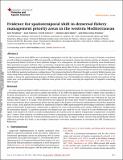Files in this item
Evidence for spatiotemporal shift in demersal fishery management priority areas in the western Mediterranean
Item metadata
| dc.contributor.author | Paradinas, Iosu | |
| dc.contributor.author | Giménez, Joan | |
| dc.contributor.author | Conesa, David | |
| dc.contributor.author | López-Quílez, Antonio | |
| dc.contributor.author | Pennino, Maria Grazia | |
| dc.date.accessioned | 2022-11-21T11:30:11Z | |
| dc.date.available | 2022-11-21T11:30:11Z | |
| dc.date.issued | 2022-10-01 | |
| dc.identifier | 281846177 | |
| dc.identifier | 4cf75059-2422-4faf-9719-eb7e84ea48b5 | |
| dc.identifier | 85139508348 | |
| dc.identifier | 000882791000001 | |
| dc.identifier.citation | Paradinas , I , Giménez , J , Conesa , D , López-Quílez , A & Pennino , M G 2022 , ' Evidence for spatiotemporal shift in demersal fishery management priority areas in the western Mediterranean ' , Canadian Journal of Fisheries and Aquatic Sciences , vol. 79 , no. 10 , pp. 1641 - 1654 . https://doi.org/10.1139/cjfas-2021-0327 | en |
| dc.identifier.issn | 0706-652X | |
| dc.identifier.other | Jisc: 629651 | |
| dc.identifier.uri | https://hdl.handle.net/10023/26450 | |
| dc.description | Funding: IP, DC, and ALP were partially funded by Fundación Biodiversidad. IP was also funded by the European Commission (GAP-847014). DC and ALQ were also funded by the Spanish Ministerio de Ciencia e Innovación——Agencia Estatal de Investigación (grant PID2019-106341GB-I00). | en |
| dc.description.abstract | Marine protected areas (MPAs) are a promising management tool for the conservation and recovery of marine ecosystems, as well as fishery management. MPAs are generally established as permanent closures but marine systems are dynamic, which has generated debate in favour of more dynamic designs. As a consequence, the identification of priority areas should assess their persistence in space and time. Here, we develop a step-by-step approach to assess the spatiotemporal dynamics of fishery management priority areas using standard fishery-independent survey data. To do so, we fit Bayesian hierarchical spatiotemporal SDM (species distribution model) models to different commercially important demersal species and use the resulting maps to fit different spatial prioritisation configurations. The proposed method is illustrated through a western Mediterranean case study using fishery-independent trawl survey data on six commercially important species collected over 17 years. We use these results to assess the spatiotemporal dynamics of fishery priority areas. We identified two fishery priority area patterns in the study area, each predominant during a different time period of the study, asserting the importance of regularly reassessing MPA designs. | |
| dc.format.extent | 14 | |
| dc.format.extent | 4216350 | |
| dc.language.iso | eng | |
| dc.relation.ispartof | Canadian Journal of Fisheries and Aquatic Sciences | en |
| dc.subject | QA Mathematics | en |
| dc.subject | QH301 Biology | en |
| dc.subject | SH Aquaculture. Fisheries. Angling | en |
| dc.subject | 3rd-DAS | en |
| dc.subject | SDG 14 - Life Below Water | en |
| dc.subject | MCC | en |
| dc.subject.lcc | QA | en |
| dc.subject.lcc | QH301 | en |
| dc.subject.lcc | SH | en |
| dc.title | Evidence for spatiotemporal shift in demersal fishery management priority areas in the western Mediterranean | en |
| dc.type | Journal article | en |
| dc.contributor.institution | University of St Andrews. School of Biology | en |
| dc.contributor.institution | University of St Andrews. Sea Mammal Research Unit | en |
| dc.identifier.doi | https://doi.org/10.1139/cjfas-2021-0327 | |
| dc.description.status | Peer reviewed | en |
This item appears in the following Collection(s)
Items in the St Andrews Research Repository are protected by copyright, with all rights reserved, unless otherwise indicated.

